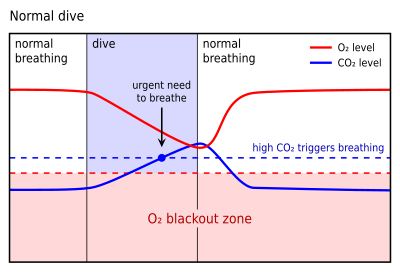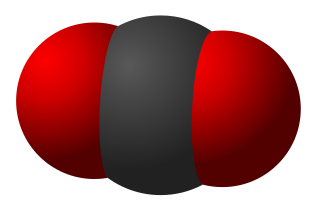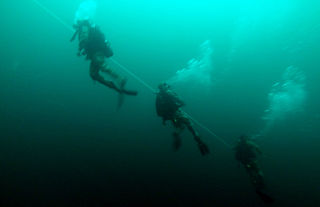Mechanisms

The minimum tissue and venous partial pressure of oxygen which will maintain consciousness is about 20 millimetres of mercury (27 mbar). [21] This is equivalent to approximately 30 millimetres of mercury (40 mbar) in the lungs. [13] Approximately 46 ml/min oxygen is required for brain function. This equates to a minimum arterial ppO2 of 29 millimetres of mercury (39 mbar) at 868 ml/min cerebral flow. [21]
Hyperventilation depletes the blood of carbon dioxide (hypocapnia), which causes respiratory alkylosis (increased pH), and causes a leftward shift in the oxygen–hemoglobin dissociation curve. This results in a lower venous partial pressure of oxygen, which worsens hypoxia. [21] A normally ventilated breath-hold usually breaks (from CO2) with over 90% saturation which is far from hypoxia. Hypoxia produces a respiratory drive but not as strong as the hypercapnic respiratory drive. [12] This has been studied in altitude medicine, where hypoxia occurs without hypercapnia due to the low ambient pressure. [13] The balance between the hypercapnic and hypoxic respiratory drives has genetic variability and can be modified by hypoxic training. These variations imply that predictive risk cannot be reliably estimated, but pre-dive hyperventilation carries definite risks. [6]
There are three different mechanisms behind blackouts in freediving: [22]
- Duration-induced hypoxia occurs when the breath is held long enough for metabolic activity to reduce the oxygen partial pressure sufficiently to cause loss of consciousness. This is accelerated by exertion, which uses oxygen faster or hyperventilation, which reduces the carbon dioxide level in the blood which in turn may:
- increase the oxygen-haemoglobin affinity thus reducing availability of oxygen to brain tissue towards the end of the dive (Bohr effect),
- suppress the urge to breathe, making it easier to hold the breath to the point of blackout. This can happen at any depth. [9] [22]
- Ischaemic hypoxia is caused by reduced blood flow to the brain arising from cerebral vasoconstriction brought on by low carbon dioxide following hyperventilation, or increased pressure on the heart as a consequence of glossopharangeal insufflation (lung packing) which can reduce blood circulation in general, or both. If the brain used more oxygen than is available in the blood supply, the cerebral oxygen partial pressure may drop below the level required to sustain consciousness. This type of blackout is likely to occur early in the dive. [22] [23]
- Ascent-induced hypoxia is caused by a drop in oxygen partial pressure as ambient pressure is reduced on ascent. The oxygen partial pressure at depth, under pressure, may be sufficient to maintain consciousness but only at that depth and not at the reduced pressures in the shallower waters above or at the surface. [10] [22] [23]
The mechanism for blackout on ascent differs from hyperventilation induced hypocapnia expedited blackouts and does not necessarily follow hyperventilation. [4] [7] However, hyperventilation will exacerbate the risk and there is no clear line between them. Shallow water blackouts can happen in extremely shallow water, even on dry land following hyperventilation and apnoea but the effect becomes much more dangerous in the ascent stage of a deep freedive. There is considerable confusion surrounding the terms shallow and deep water blackout and they have been used to refer to different things, or be used interchangeably, in different water sports circles. For example, the term shallow water blackout has been used to describe blackout on ascent because the blackout usually occurs when the diver ascends to a shallow depth. [9] [10] [24] For the purposes of this article there are two separate phenomena Shallow water blackout and Blackout on ascent as follows:
Shallow water blackout

Otherwise unexplained blackouts underwater have been associated with the practice of hyperventilation. [2] [3] [4] [25] Survivors of shallow water blackouts often report using hyperventilation as a technique to increase the time they can spend underwater. Hyperventilation, or over-breathing, involves breathing faster and/or deeper than the body naturally demands and is often used by divers in the mistaken belief that this will increase oxygen saturation. Although this appears true intuitively, under normal circumstances the breathing rate dictated by the body alone already leads to 98–99% oxygen saturation of the arterial blood and the effect of over-breathing on the oxygen intake is minor. What is really happening differs from divers' understanding; these divers are extending their dive by postponing the body's natural breathing mechanism, not by increasing oxygen load. [10] The mechanism is as follows:
The primary urge to breathe is triggered by rising carbon dioxide (CO2) levels in the bloodstream. [25] Carbon dioxide builds up in the bloodstream when oxygen is metabolized and it needs to be expelled as a waste product. The body detects carbon dioxide levels very accurately and relies on this as the primary trigger to control breathing. [25] Hyperventilation artificially depletes the resting concentration of carbon dioxide causing a low blood carbon dioxide condition called hypocapnia. Hypocapnia reduces the reflexive respiratory drive, allowing the delay of breathing and leaving the diver susceptible to loss of consciousness from hypoxia. For most healthy people, the first sign of low oxygen levels is a greyout or unconsciousness: there is no bodily sensation that warns a diver of an impending blackout. [10]
Significantly, victims drown quietly underwater without alerting anyone to the fact that there is a problem and are typically found on the bottom as shown in the staged image above. Survivors of shallow water blackout are typically puzzled as to why they blacked out. Pool life guards are trained to scan the bottom for the situation shown.[ citation needed ]
Breath-hold divers who hyperventilate before a dive increase their risk of drowning. Many drownings unattributed to any other cause result from shallow water blackout and could be avoided if this mechanism was properly understood and the practice eliminated. Shallow water blackout can be avoided by ensuring that carbon dioxide levels in the body are normally balanced prior to diving and that appropriate safety measures are in place. [1] [5]
A high level of hypocapnia is readily identifiable as it causes dizziness and tingling of the fingers. These extreme symptoms are caused by the increase of blood pH (alkalosis) following the reduction of carbon dioxide, which acts to lower the pH of the blood. The absence of any symptoms of hypocapnia is not an indication that the diver's carbon dioxide is within safe limits and cannot be taken as an indication that it is therefore safe to dive. Conservative breath-hold divers who hyperventilate but stop doing so before the onset of these symptoms are likely to be already hypocapnic without knowing it. [12]
Note that the urge to breathe is triggered by rising carbon dioxide levels in the blood and not by the reduction of oxygen. The body can actually detect low levels of oxygen but this is not normally perceptible prior to blackout. [10] Persistently elevated levels of carbon dioxide in the blood, hypercapnia (the opposite to hypocapnia), tend to desensitise the body to carbon dioxide, in which case the body may come to rely on the oxygen level in the blood to maintain respiratory drive. This is illustrated in the scenario of type II respiratory failure. However, in a normal healthy person there is no subjective awareness of low oxygen levels. [12]
Ascent blackout

An ascent blackout, or deep water blackout, is a loss of consciousness caused by cerebral hypoxia on ascending from a deep freedive or breath-hold dive, typically of ten metres or more when the swimmer does not necessarily experience an urgent need to breathe and has no other obvious medical condition that might have caused it. [2] [3] [7] [10] Victims typically black out close to the surface, usually within the top three metres, sometimes even as they break surface and have often been seen to approach the surface without apparent distress only to sink away. It is quite rare for blackouts to occur while at the bottom or in the early stages of ascent; divers who drown in these stages are usually found to have inhaled water, indicating that they were conscious and succumbed to an uncontrollable urge to breathe rather than blacking out. Victims are usually established practitioners of deep breath-hold diving, are fit, strong swimmers and have not experienced problems before. Blackout by this mechanism may occur even after surfacing from depth and breathing has commenced if the inhaled oxygen has not yet reached the brain and may be referred to as a surface blackout. [5]
The partial pressure of oxygen in the air in the lungs controls the oxygen loading of blood. A critical pO2 of 30 millimetres of mercury (40 mbar) in the lungs will sustain consciousness when breathing is resumed after a breath-hold dive. This is about 4% oxygen in the lungs and 45% oxygen saturation of the arterial blood. At 30 msw (4 bar), 2% by volume oxygen in the lung gas gives a pO2 of 60 millimetres of mercury (80 mbar). At 10 msw (2 bar), for the same 2% oxygen, the pO2 would be 30 millimetres of mercury (40 mbar), i.e. marginal. At the surface the same 2% oxygen drops to 15 millimetres of mercury (20 mbar), ignoring metabolic use. [13]
Three factors are thought to be involved: Voluntary suppression of breathing and rapid depressurisation are necessarily present, and self-induced hypocapnia by hyperventilation is known to be present in many cases. Depressurisation on ascent is an explanation for the shallow depth of ascent blackouts but does not fully explain all cases unless accompanied by an underlying suppression of the urge to breathe through self-induced hypocapnia via hyperventilation.
- Voluntary suppression of breathing. Deep water blackout is sometimes attributed simply to the practiced diver's ability through training to suppress the urge to breathe. If surviving divers are aware that they have heavily suppressed the urge to breathe towards the end of the dive there is a tendency to look no further for an explanation.[ citation needed ] However, there are two problems with this as an explanation:
- Even with a high level of training the hypercapnic urge to breathe is almost impossible to overcome; swimmers typically suffer an uncontrollable, violent, deep inhalation of water even when, intellectually, they know that to do so is fatal. This is a simple case of running out of air and drowning.[ citation needed ] Victims of ascent blackout, if they have any water in the lungs at all will have a limited amount in the bronchi consistent with natural ingress after death.[ citation needed ]
- Victims of deep water blackout closely observed from both below and above water do not exhibit the signs of distress associated with an uncontrollable urge to breathe and those that have survived a blackout report no such distress. Many blackout events have been closely observed and even filmed because deep dynamic apnoea dives are a competitive event and very deep dives require a considerable support crew both above and below water. Anecdotal accounts of healthy divers holding their breath to the point of unconsciousness without hyperventilation are difficult to substantiate and the ability, if it exists, is certainly extremely rare.[ citation needed ]
- Rapid depressurisation. Because ascent blackout occurs as the diver approaches the surface from a deep dive, depressurisation is clearly present. Consciousness depends on a minimum partial pressure of oxygen in the brain, not on the absolute quantity of the gas in the system. [13] At the surface, the air in the lungs is under 1 atmosphere of pressure; at 10 metres, the water pressure doubles the pressure of air in the lungs to 2 atmospheres. [26] Recreational breath-hold dives can often go below 20 metres, competitive divers can go much deeper, and the "No limits" free-dive record exceeds 200 metres since 2007. [27] Ten metres is easily achievable by a reasonably fit and competent swimmer.[ citation needed ] Most people lose consciousness when the partial pressure of oxygen in their lungs, normally 105 millimetres of mercury (140 mbar) falls below about 30 millimetres of mercury (40 mbar). [13] A ppO2 of 45 millimetres of mercury (60 mbar) at ten metres will be tolerable to the diver while at that depth, but is likely to result in a blackout between four metres and the surface when the ambient pressure reduction brings the partial pressure of oxygen below the limit. S. Miles termed this latent hypoxia. [10] Although quite comfortable at the bottom the diver may actually be trapped by latent hypoxia, and unaware that it is now no longer possible to ascend safely, but is likely to black out without warning just as he or she approaches the surface. [13]
- Self-induced hypocapnia. Hyperventilation leading to hypocapnia and subsequent loss of an appropriate urge to breathe is the mechanism behind shallow water blackout. Many practitioners of deep water breath-hold diving use hyperventilation with the intention of extending their bottom time, so this mechanism is also relevant to deep water blackouts in those cases.[ citation needed ] If the diver has hyperventilated, the mechanism is essentially that for shallow water blackout but hypoxia is delayed by pressure at depth and sets in only when the pressure drops while surfacing. This explains why divers who black out like this do so very close to the surface on their way up and why they may not have felt any urgency to breathe at all; fit, free-divers ascending from deep dives can black out without any warning.[ citation needed ]
Surface blackout
Surface blackout occurs just after the diver exhales on the surface, and may happen before, during or after inhalation of the first breath. When the diver exhales, there is usually a reduction of intrathoracic pressure, which is exacerbated by the effort of inhalation, which can further compromise the partial pressure of oxygen in the alveolar capillaries, and after a small time lag, the oxygen supply to the brain. The exhalation also reduces the buoyancy of the diver and increases the risk of sinking as a consequence of blackout. The drop in intrathoracic pressure may also reduce cardiac output for this period and thereby further compromise the cerebral oxygen supply. [28] The delay between breathing and the oxygenated blood reaching the brain can exceed 15 seconds. Competitive freediving safety monitors watch the diver for at least 30 seconds after surfacing. Recovery breathing may reduce the risk of surface blackout during the critical period after surfacing. [15]












